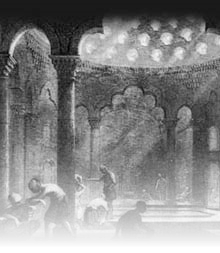










Like its Roman predecessor a typical hamam consists of three basic,
interconnected rooms: the sıcaklık (or hararet -caldarium), which is the
hot room; the warm room (tepidarium), which is the intermediate room;
and the soğukluk, which is the cool room (frigidarium). The main
evolutionary change between Roman baths and Turkish baths concerns
the cool room. The Roman frigidarium included a quite cold water pool in
which patrons would immerse themselves before moving on to the
warmer rooms. Medieval Muslim customs put a high priority on
cleanliness, but favored running water to immersion baths, so the cold
water pool was dispensed with. Also the sequence of rooms was revised
so that people generally used the cool room after the warmer rooms and
massages, rather than before. Whereas the Romans used it as
preparation, the Ottomans used it for refreshment (drinks and snacks are
served) and recovery.
The sıcaklık usually has a large dome decorated with small glass windows
that create a half-light; it also contains a large marble stone called göbek
taşı (tummy stone) at the center that the customers lie on, and niches
with fountains in the corners. This room is for soaking up steam and
getting scrub massages. The warm room is used for washing up with soap
and water and the soğukluk is to relax, dress up, have a refreshing drink,
sometimes tea, and, where available, a nap in a private cubicle after the
massage. A few of the hamams in Istanbul also contain mikvehs, ritual
cleansing baths for Jewish women.









The hamam, like its precursors, is not exclusive to men. Hamam complexes usually contain separate quarters for men and
women; or males and females are admitted at separate times. Because they were social centers as well as baths hamams
became numerous during the time of the Ottoman Empire and were built in almost every Ottoman city. On many
occasions they became places of entertainment (e.g. dancing and food, especially in the women's quarters) and
ceremonies, such as before weddings, high-holidays, celebrating newborns, beauty trips.
Several accessories from Roman times survive in modern hamams, such as the peştemal (a special cloth of silk and/or
cotton to cover the body, like a pareo), nalın (wooden clogs that prevent slipping on the wet floor, or mother-of-pearl),
kese (a rough mitt for massage), and sometimes jewel boxes, gilded soap boxes, mirrors, henna bowls, and perfume
bottles.according to requests.
Tellak
Traditionally, the masseurs in the baths, tellak in Turkish, were young men who helped wash clients by soaping and
scrubbing their bodies. They were recruited from among the ranks of the non-Muslim subject nations of the Turkish
empire, such work being seen as beneath the dignity of a Muslim.
After the defeat and dismemberment of the Ottoman army in the early 20th century, the role of tellak boys was filled by
adult attendants.
1 l 2